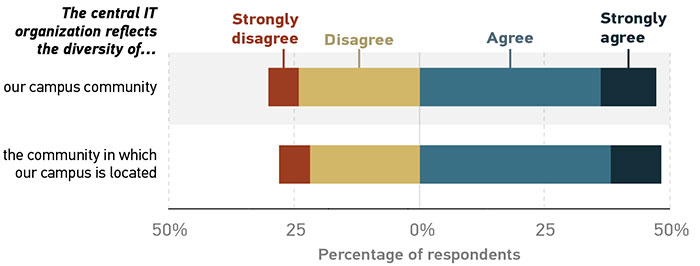The IT Workforce Is Diverse ... for Some
The Delphic maxim to "know thyself," a critical aspect of Socratic thought, suggests that in order to know one's place in the world and how to relate to others, we need to reflect critically on who we are and how our own unconscious biases1 might be shaping our perceptions and actions. Higher education IT is at a crossroads in terms of addressing a host of issues related to DEI. But to understand how to approach the issue of improving diversity, establishing equitable policies, and becoming more inclusive, higher education IT needs to "know itself" and understand the current workforce landscape.
In addition to reporting on the composition of the higher education IT workforce, as we did in our report The Higher Education IT Workforce Landscape, 2019, asking higher education IT employees whether their unit reflects the diversity of their campus or community provides a set of data points that help us understand how well IT knows itself. Whether or not the responses reflect the actual alignment of the community, campus, and unit on various demographics is beside the point here; the perception of whether an IT unit successfully mirrors the broader sociological context from which it is derived and in which it is nested is what really matters in this instance. If individuals do not see the community and campus reflected in the workplace, then this is a problem.
Almost half of respondents agreed that their central IT organization reflects the diversity of their campus community (47%) and the community where their campus is located (49%) (figure 1). On the other hand, nearly a third of our respondents believe otherwise; 29% disagreed that their IT organization mirrors their campus, and 28% said the same for their campus vicinity. There were no significant differences in these perceptions of diversity across ethnicities or for employees who identified as LGBQ; both of these groups generally agreed that their central IT units are a reflection of both their larger campus and the surrounding communities. However, we did observe an association in these areas based on other demographic factors. Millennials reported higher rates of disagreement in these areas, as did individuals with disabilities. And we found a highly significant difference based on gender: significantly more women than men said the diversity in their central IT organizations was not reflective of their on- and off-campus communities.

These findings are better understood when we consider what we learned about the makeup of the IT workforce in the 2019 IT workforce in higher education study.2 In our sample, Baby Boomers and Gen Xers outnumbered Millennials, so their responses about diversity in their IT organization in comparison to other communities could point to this generational disparity. The same could also be true for the differences we observed between genders; women made up only 38% of the higher education IT workforce study respondents. And only 8% of the workforce reported having a disability or impairment.
Individuals in a dominant group may believe the workforce to be more diverse than it actually is. Other researchers have explored similar workplace issues and the differences between male and female perceptions. For example, findings from the 2017 Women in the Workplace report revealed that almost half of men—and a third of women—believed women were well represented in leadership positions in organizations where only 1 in 10 among the senior ranks were female.3 The report argues that we have diversity "blind spots" that are perpetuated by the status quo, and this can be a problem; that is, if the perception of diversity is better than the reality, then the urgency to implement change may very well wane—or worse, stall entirely. These perception differences among men and women about what constitutes diversity and how much is enough may also exist in the higher education IT workforce. Offering training on unconscious bias or other DEI-related issues can help IT organizations address diversity blind spots and challenge the status quo idea that having only one or just a few employees from underrepresented groups is enough to make a unit diverse. The 2017 Women in the Workplace report also recommends setting targets for gender representation across ranks, tracking those data, and sharing those metrics with all employees to create accountability and foster results.
Notes
-
Unconscious, or implicit, bias "is often defined as prejudice or unsupported judgments in favor of or against one thing, person, or group as compared to another, in a way that is usually considered unfair." For more on what unconscious bias is and how to combat it, see Unconscious Bias.
↩︎ -
Galanek, Gierdowski, and Brooks, The Higher Education IT Workforce Landscape, 2019.
↩︎ -
"Women in the Workplace, 2017," McKinsey & Company and Lean In, October 2017.
↩︎